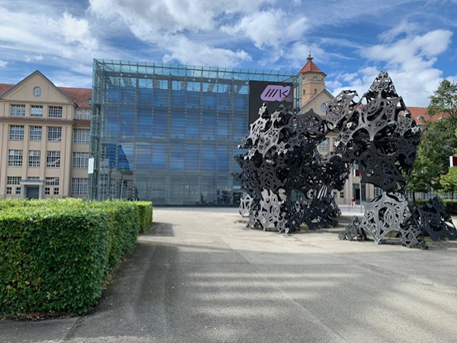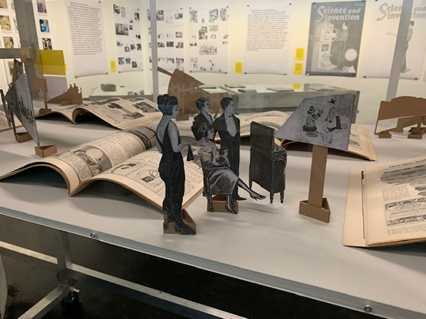Elizabeth Thompson-MacRae is Digital Archivist for the University of St Andrews. She attended the NTTW8 Conference with support from the DPC Career Development Fund, which is funded by DPC Supporters.
I'm writing this under a shaded tree in the grounds of the Centre for Art and Media Karlsruhe (otherwise known as ZKM). It’s a beautiful, peaceful space, dispersed with planted green spaces, punctuated by outdoor sculpture. A world away from the site’s munition manufacturing past.
Walking around ZKM, I wonder if the munition workers could imagine the space in which it has become, an innovative centre for creativity, showcasing boundary pushing work to bring to life and preserve and provide access to audio visual (AV) media?

Image of the front of the Centre for Art and Media, Karlsruhe on a sunny day. Showing a glass cube attached to the 19th century, red roofed munitions factory with an intricate metal sculpture of many cogs and gears in the foreground.
ZKM provides the backdrop for the 8th edition of the No Time to Wait (NTTW) Conference that connects professionals working within the sphere of AV preservation to network, share and learn from each other. As a recipient of a grant from the DPC Career Development Fund, it was possible for me to experience the collective knowledge from the No Time to Wait community in person.
Over the three-day conference, delegates had the opportunity to view currently running exhibitions and behind-the-scenes operations in the conservation studio and AV suite.
Led by ZKM’s Archivist, Felix Mittleberger, I took the opportunity to have a guided tour of the exhibition ‘Antenna: Frequencies from the Archive’. In collaboration with students, the exhibition explored gaps within the archive to draw out narratives from underrepresented communities.
One project, ‘Future Present’, considered how inventors visualised the role in which technology might play in the future. Through diorama, selected illustrations of technology from the early 20th century publication ‘Science and Invention’ were given a fresh perspective. The 3D representation of flat images invited visitors to conceptualise a vision of the future in spatial terms and how that might be experienced by the people using such technology.

Image of a cardboard diorama created from a black and white image cut out from ‘Science and Invention’ of people dressed in early 20th century evening attire watching a moving image from a projector.
The concept of ‘Future, Present’ resonated with me and gave pause for reflection. Woking with digital archives places archivists like me, in multiple realities. In every decision we take, we are working with the past, in the present, to provide access in the future. This concept is not so different to other archival formats. However, it is unlike paper which has a well-established past and, with that, a reasonable certainty of a future present. Digital collections are the antithesis to this. Not enough time has lapsed to have a secure knowledge of the future, yet at the same time, for some AV formats, too much time has already lapsed to be accessible. I must admit that I, at times, can find this challenge almost overwhelming and wonder how my decisions will be viewed in a future past context.
Circling back to No Time to Wait's core premise is promoting open-source solutions to provide that platform of stability. As a ‘newbie,’ working within the digital AV preservation space, I didn't fully appreciate the implications of open-source formats to secure a digital future. Since attending the conference and taking part in the active conversations with fellow professionals, I now understand the importance of the continuation of support of open-source tools to create a sustainable and level playing field for organisations of any budget to access a digital future past.
The decisions that we do or do not take will be judged retrospectively by the future audiences and the anxiety around those decisions will be lost to time. We have not yet figured everything out, but it is assuring to know that there are talented professionals working across interdisciplinary boundaries to meet those challenges to ensure that there will be a future past for successive generations to reflect on and possibly raise a wry smile.
Acknowledgements
The Career Development Fund is sponsored by the DPC’s Supporters who recognize the benefit and seek to support a connected and trained digital preservation workforce. We gratefully acknowledge their financial support to this programme and ask applicants to acknowledge that support in any communications that result. At the time of writing, the Career Development Fund is supported by Arkivum, Artefactual Systems Inc., boxxe, Cerabyte, Evolved Binary, Ex Libris, Iron Mountain, Libnova, Max Communications, Preservica and Simon P Wilson. A full list of supporters is online here.













































































































































